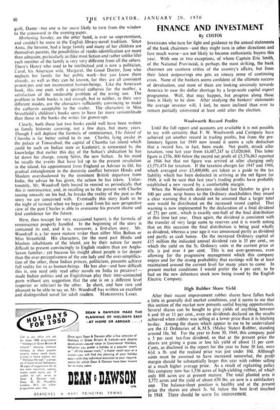FINANCE AND INVESTMENT
By CUSTOS
INVESTORS who turn for light and guidance to the annual statements of the bank chairmen—and they might turn in other directions and fare much worse—are not likely to become enthusiastic buyers this year. With one or two exceptions, of whom Captain Eric Smith, of the National Provincial, is perhaps the most striking, the bank chairmen are cautious critics of the country's affairs, but from their latest outpourings one gets an uneasy sense of continuing crisis. None of the bankers seems confident of the ultimate success of devaluation, and most of them are looking anxiously towards America to ease the dollar shortage by a large-scale capital export programme. Well, that may happen, but progress along those lines is likely to be slow. After studying the bankers' statements the average investor will, I feel, be more inclined than ever to remain partially uninvested at least until after the election.
Woolworth Record Profits Until the full report and accounts are available it is not possibly to say with certainty that F. W. Woolworth and Company have achieved yet another record in trading profits, but from the pre- liminary figures for 1949 now issued it seems a safe deduction that a record has, in fact, been made. Net profit, struck after taxation, rose last year from £4,487,247 to £5,020,060. This latter figure is £556, 800 below the record net profit of £5,576,863 reported in 1946 but that net figure was arrived at after charging only £3,571,474 for taxation. If the taxation charges for 1947 and 1948, which averaged over £5,400,000, are taken as a guide to the tax liability which has been deducted in arriving at the net figure for 1949, it will be seen that last year's trading profits have probably -established a new record by a comfortable margin.
When the Woolworth directors decided last October to give a 100 per cent. scrip bonus to the Ordinary stockholders they issued a clear warning that it should not be assumed that a larger total sum would be distributed on the increased issued capital. That warning is now implemented by the declaration of a final dividend of 27-1 per cent., which is exactly one-half of the final distribution at this time last year. Once again, the dividend is consistent with the transfer of very large sums to reserves and it is worth noting that on this occasion the final distribution is being paid wholly as dividend, whereas a year ago it was announced partly as dividend and partly as cash bonus. On the increased Ordinary capital of £15 million the indicated annual dividend rate is 35 per cent., on which the yield on the 5s. Ordinary units at the current price of 43s. is just over 4 per cent. This is not over-generous, even allowing for the progressive management which this company enjoys and for the strong probability that earnings will be at least maintained around the current level for many years to come. In present market conditions I would prefer the 4 per cent. to be had on the new debenture stock now being issued by the English Electric Company.
High Rubber Share Yield
After their recent improvement rubber shares have fallen back a little in generally dull market conditions, and it seems to me that this section of the market now presents useful buying opportunities. Several shares can be bought to give yields of anything, between 6 and 10 or 11 per cent., even on dividends declared on the results achieved when rubber was selling at a lower price than it is fetching to-day. Among the shares which appear to me to be undervalued are the £1 Ordinaries of K.M.S. (Malay States) Rubber, standing around 18s. 9d. For the year to June 30, 1949, this company paid a 5 per cent tax-free dividend, so. that at the present price the shares are giving a gross or less tax yield of about 11 per cent. Costs, as disclosed in the report for the year to June 30 last, were 60. a lb. and the realised price was just under 10d. Although costs must be assumed to have increased somewhat, the profit margin should be substantially larger this- year with rubber selling at a much higher average price. As a result of replanting policy this company now has 1,536 acres of high-yielding rubber, of which only 808 acres are at present mature. The total planted area is 3,772 acres and the yield of about 670 lbs. an acre is a satisfactory one. The balance-sheet position is healthy and at the present price the shares are about 3s. 9d. below the best level touched in 1948. There should be scope for improvement.


































 Previous page
Previous page